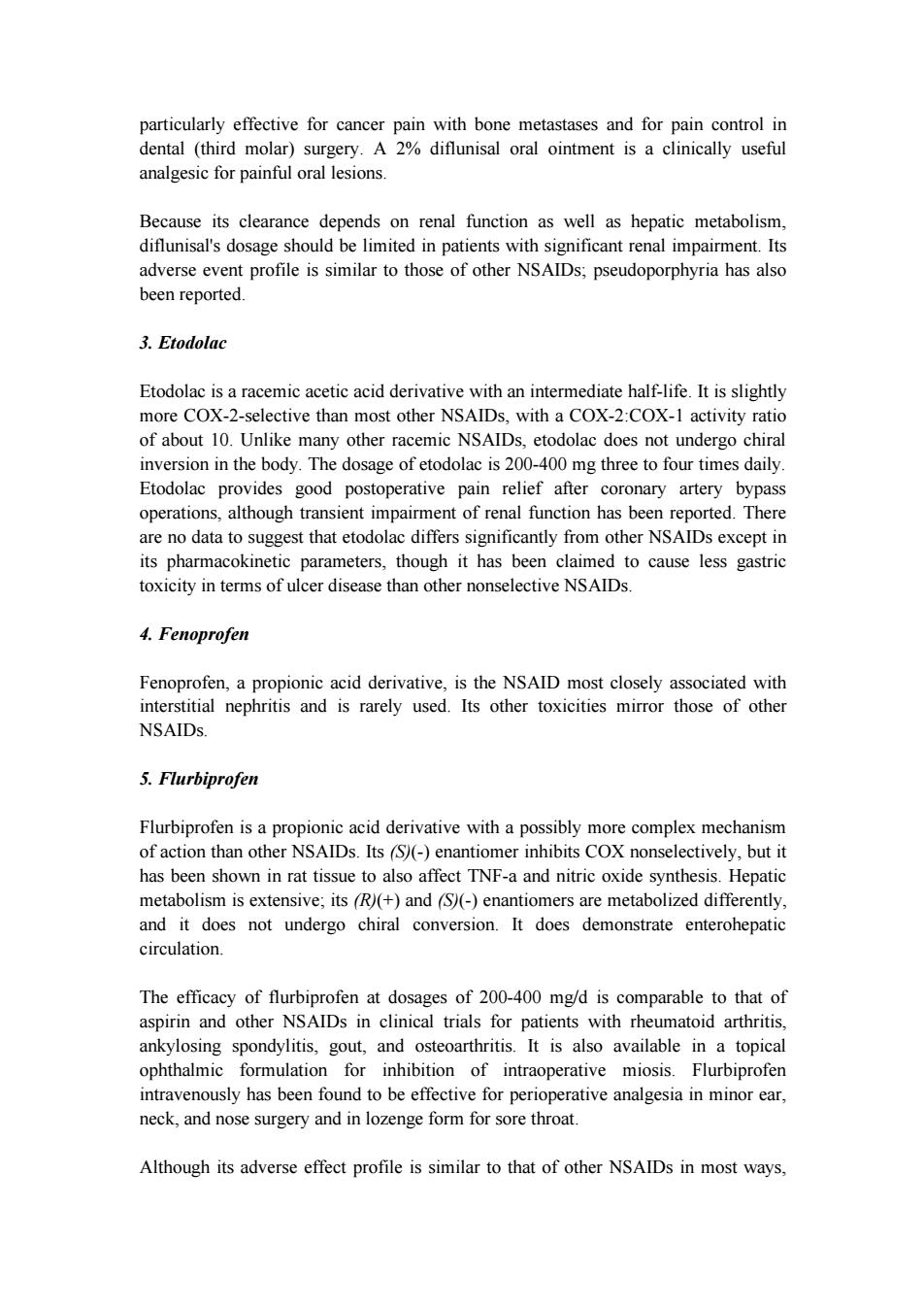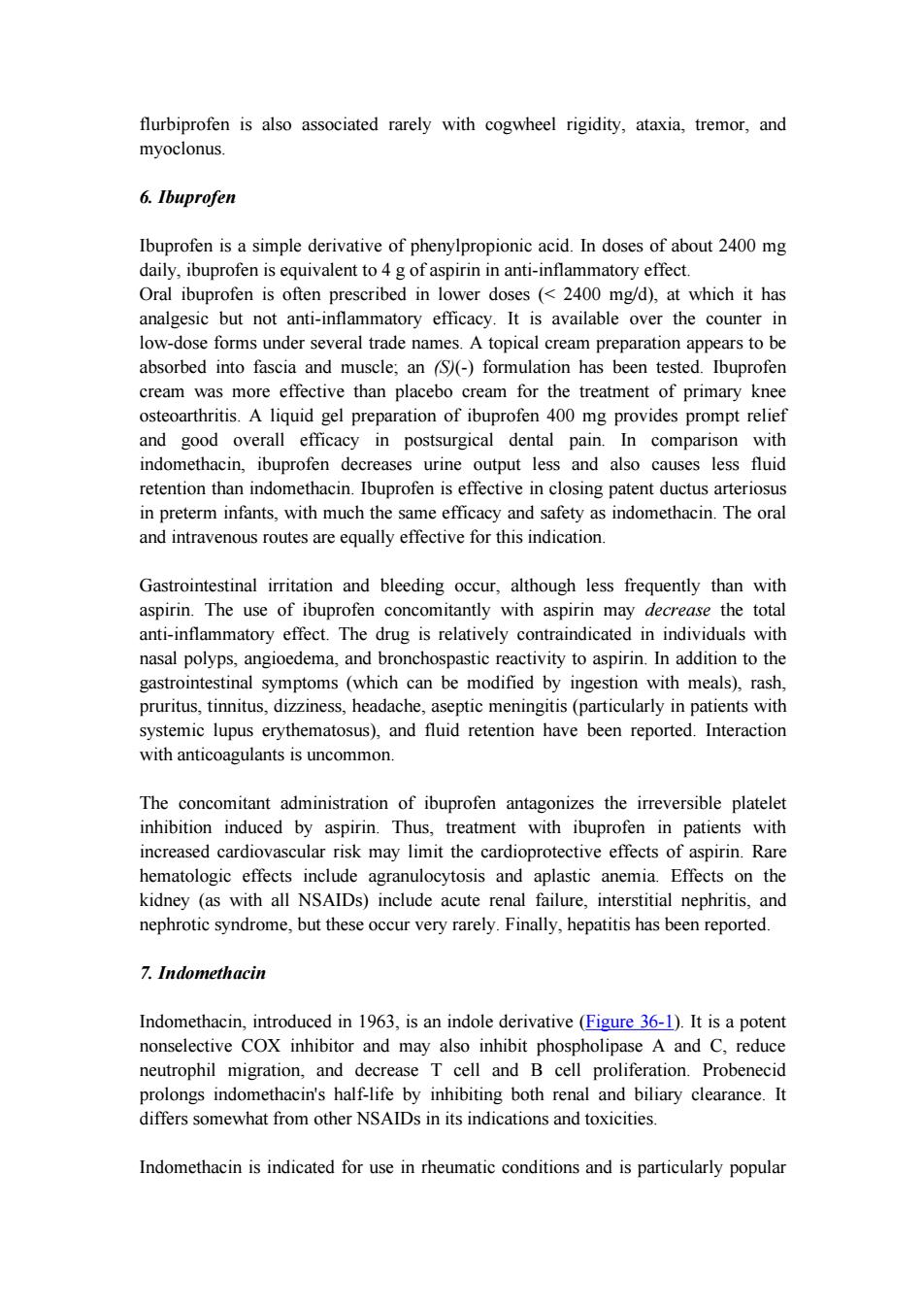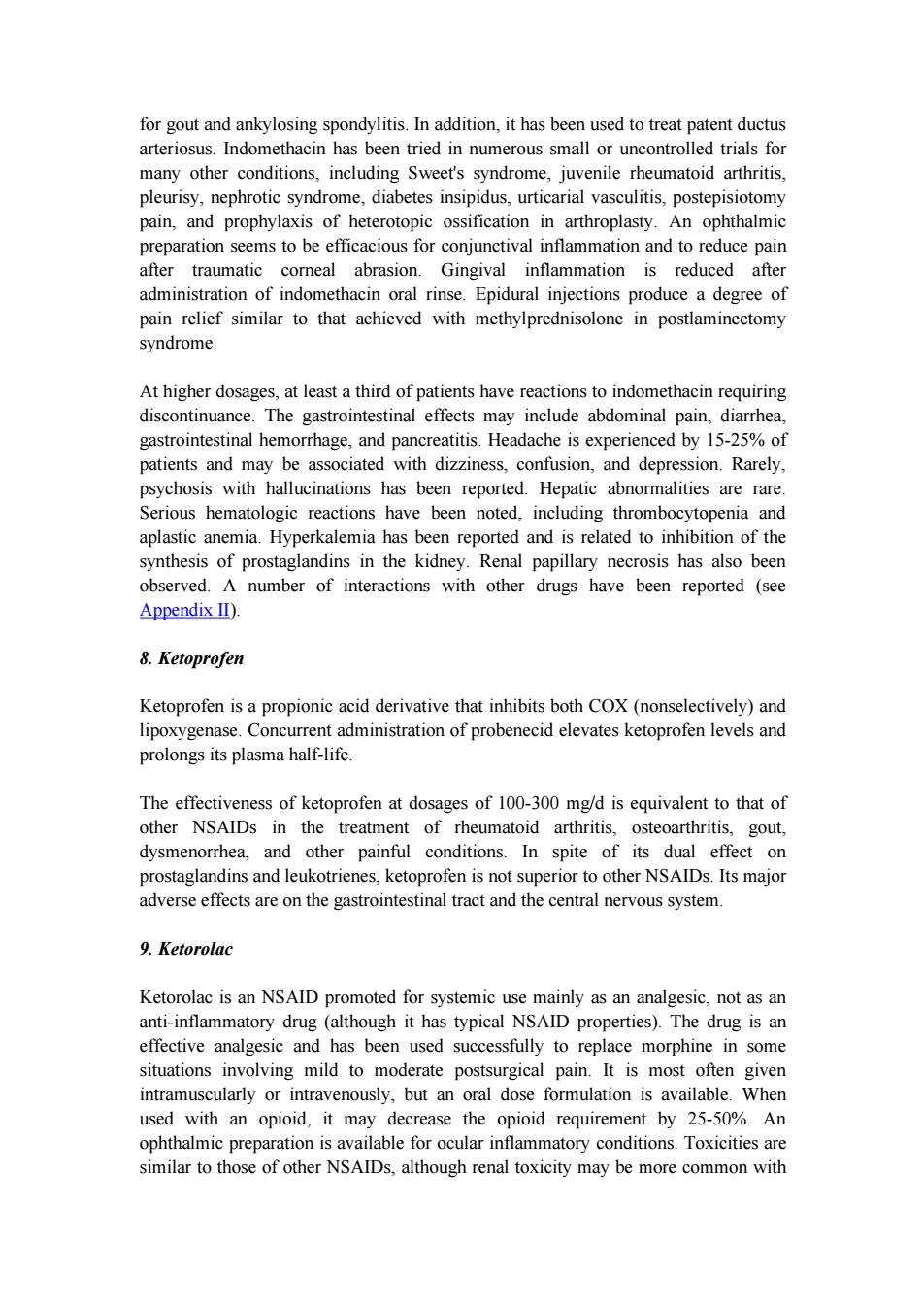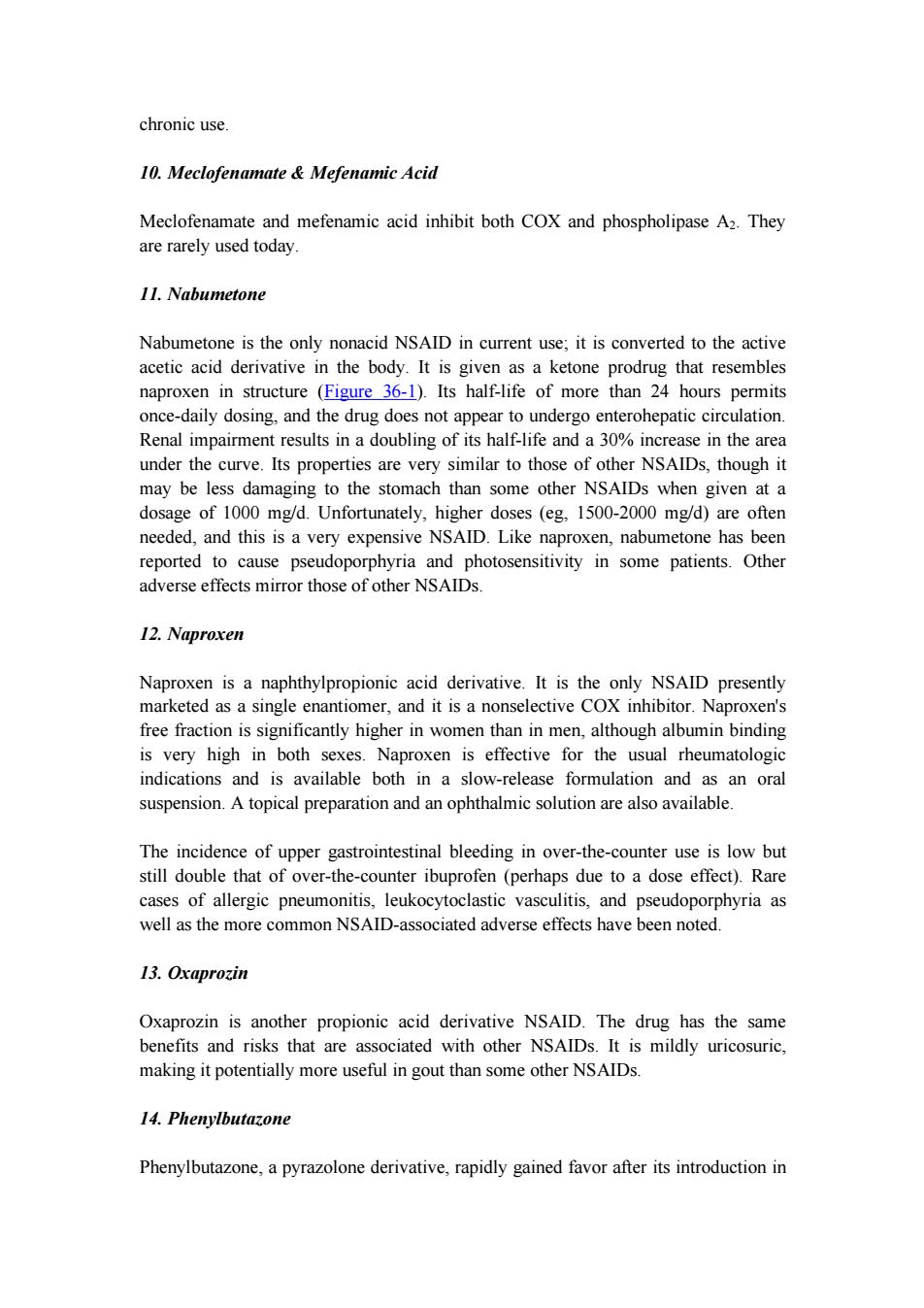
4.Valdecoxib Valdecoxib,a diaryl-substituted isoxazole,is a new highly selective COX-2 inhibitor. The analgesic dose for valdecoxib is 20 mg twice daily.Gastrointestinal and other toxicities are similar to those of the other coxibs.Valdecoxib has no effect on platelet aggregation or bleeding time.Serious reactions have been reported in sulfonamide-sensitive individuals.Valdecoxib was withdrawn from the market in the USA in early 2005 in response to FDA concerns about cardiovascular risks and Stevens-Johnson syndrome,but the drug is still available in other countries. NONSELECTIVE COX INHIBITORS 1.Diclofenac Diclofenac is a phenylacetic acid derivative that is relatively nonselective as a COX inhibitor. Adverse effects occur in approximately 20%of patients and include gastrointestinal distress,occult gastrointestinal bleeding,and gastric ulceration,though ulceration may occur less frequently than with some other NSAIDs.A preparation combining diclofenac and misoprostol decreases upper gastrointestinal ulceration but may result in diarrhea.Another combination of diclofenac and omeprazole was also effective with respect to the prevention of recurrent bleeding,but renal adverse effects were common in high-risk patients.Diclofenac at a dosage of 150 mg/d appears to impair renal blood flow and glomerular filtration rate.Elevation of serum aminotransferases may occur more commonly with this drug than with other NSAIDs. A 0.1%ophthalmic preparation is recommended for prevention of postoperative ophthalmic inflammation and can be used after intraocular lens implantation and strabismus surgery.A topical gel containing 3%diclofenac is effective for solar keratoses.Diclofenac in rectal suppository form can be considered a drug of choice for preemptive analgesia and postoperative nausea.In Europe,diclofenac is also available as an oral mouthwash and for intramuscular administration. 2.Diflunisal Although diflunisal is derived from salicylic acid,it is not metabolized to salicylic acid or salicylate.It undergoes an enterohepatic cycle with reabsorption of its glucuronide metabolite followed by cleavage of the glucuronide to again release the active moiety.Diflunisal is subject to capacity-limited metabolism,with serum half-lives at various dosages approximating that of salicylates.In rheumatoid arthritis the recommended dose is 500-1000 mg daily in two divided doses.It is claimed to be
4. Valdecoxib Valdecoxib, a diaryl-substituted isoxazole, is a new highly selective COX-2 inhibitor. The analgesic dose for valdecoxib is 20 mg twice daily. Gastrointestinal and other toxicities are similar to those of the other coxibs. Valdecoxib has no effect on platelet aggregation or bleeding time. Serious reactions have been reported in sulfonamide-sensitive individuals. Valdecoxib was withdrawn from the market in the USA in early 2005 in response to FDA concerns about cardiovascular risks and Stevens-Johnson syndrome, but the drug is still available in other countries. NONSELECTIVE COX INHIBITORS 1. Diclofenac Diclofenac is a phenylacetic acid derivative that is relatively nonselective as a COX inhibitor. Adverse effects occur in approximately 20% of patients and include gastrointestinal distress, occult gastrointestinal bleeding, and gastric ulceration, though ulceration may occur less frequently than with some other NSAIDs. A preparation combining diclofenac and misoprostol decreases upper gastrointestinal ulceration but may result in diarrhea. Another combination of diclofenac and omeprazole was also effective with respect to the prevention of recurrent bleeding, but renal adverse effects were common in high-risk patients. Diclofenac at a dosage of 150 mg/d appears to impair renal blood flow and glomerular filtration rate. Elevation of serum aminotransferases may occur more commonly with this drug than with other NSAIDs. A 0.1% ophthalmic preparation is recommended for prevention of postoperative ophthalmic inflammation and can be used after intraocular lens implantation and strabismus surgery. A topical gel containing 3% diclofenac is effective for solar keratoses. Diclofenac in rectal suppository form can be considered a drug of choice for preemptive analgesia and postoperative nausea. In Europe, diclofenac is also available as an oral mouthwash and for intramuscular administration. 2. Diflunisal Although diflunisal is derived from salicylic acid, it is not metabolized to salicylic acid or salicylate. It undergoes an enterohepatic cycle with reabsorption of its glucuronide metabolite followed by cleavage of the glucuronide to again release the active moiety. Diflunisal is subject to capacity-limited metabolism, with serum half-lives at various dosages approximating that of salicylates. In rheumatoid arthritis the recommended dose is 500-1000 mg daily in two divided doses. It is claimed to be

particularly effective for cancer pain with bone metastases and for pain control in dental (third molar)surgery.A 2%diflunisal oral ointment is a clinically useful analgesic for painful oral lesions. Because its clearance depends on renal function as well as hepatic metabolism, diflunisal's dosage should be limited in patients with significant renal impairment.Its adverse event profile is similar to those of other NSAIDs;pseudoporphyria has also been reported. 3.Etodolac Etodolac is a racemic acetic acid derivative with an intermediate half-life.It is slightly more COX-2-selective than most other NSAIDs,with a COX-2:COX-1 activity ratio of about 10.Unlike many other racemic NSAIDs,etodolac does not undergo chiral inversion in the body.The dosage of etodolac is 200-400 mg three to four times daily. Etodolac provides good postoperative pain relief after coronary artery bypass operations,although transient impairment of renal function has been reported.There are no data to suggest that etodolac differs significantly from other NSAIDs except in its pharmacokinetic parameters,though it has been claimed to cause less gastric toxicity in terms of ulcer disease than other nonselective NSAIDs. 4.Fenoprofen Fenoprofen,a propionic acid derivative,is the NSAID most closely associated with interstitial nephritis and is rarely used.Its other toxicities mirror those of other NSAIDs 5.Flurbiprofen Flurbiprofen is a propionic acid derivative with a possibly more complex mechanism of action than other NSAIDs.Its (S)(-)enantiomer inhibits COX nonselectively,but it has been shown in rat tissue to also affect TNF-a and nitric oxide synthesis.Hepatic metabolism is extensive;its (R(+)and (S)(-)enantiomers are metabolized differently, and it does not undergo chiral conversion.It does demonstrate enterohepatic circulation. The efficacy of flurbiprofen at dosages of 200-400 mg/d is comparable to that of aspirin and other NSAIDs in clinical trials for patients with rheumatoid arthritis, ankylosing spondylitis,gout,and osteoarthritis.It is also available in a topical ophthalmic formulation for inhibition of intraoperative miosis.Flurbiprofen intravenously has been found to be effective for perioperative analgesia in minor ear, neck,and nose surgery and in lozenge form for sore throat. Although its adverse effect profile is similar to that of other NSAIDs in most ways
particularly effective for cancer pain with bone metastases and for pain control in dental (third molar) surgery. A 2% diflunisal oral ointment is a clinically useful analgesic for painful oral lesions. Because its clearance depends on renal function as well as hepatic metabolism, diflunisal's dosage should be limited in patients with significant renal impairment. Its adverse event profile is similar to those of other NSAIDs; pseudoporphyria has also been reported. 3. Etodolac Etodolac is a racemic acetic acid derivative with an intermediate half-life. It is slightly more COX-2-selective than most other NSAIDs, with a COX-2:COX-1 activity ratio of about 10. Unlike many other racemic NSAIDs, etodolac does not undergo chiral inversion in the body. The dosage of etodolac is 200-400 mg three to four times daily. Etodolac provides good postoperative pain relief after coronary artery bypass operations, although transient impairment of renal function has been reported. There are no data to suggest that etodolac differs significantly from other NSAIDs except in its pharmacokinetic parameters, though it has been claimed to cause less gastric toxicity in terms of ulcer disease than other nonselective NSAIDs. 4. Fenoprofen Fenoprofen, a propionic acid derivative, is the NSAID most closely associated with interstitial nephritis and is rarely used. Its other toxicities mirror those of other NSAIDs. 5. Flurbiprofen Flurbiprofen is a propionic acid derivative with a possibly more complex mechanism of action than other NSAIDs. Its (S)(-) enantiomer inhibits COX nonselectively, but it has been shown in rat tissue to also affect TNF-a and nitric oxide synthesis. Hepatic metabolism is extensive; its (R)(+) and (S)(-) enantiomers are metabolized differently, and it does not undergo chiral conversion. It does demonstrate enterohepatic circulation. The efficacy of flurbiprofen at dosages of 200-400 mg/d is comparable to that of aspirin and other NSAIDs in clinical trials for patients with rheumatoid arthritis, ankylosing spondylitis, gout, and osteoarthritis. It is also available in a topical ophthalmic formulation for inhibition of intraoperative miosis. Flurbiprofen intravenously has been found to be effective for perioperative analgesia in minor ear, neck, and nose surgery and in lozenge form for sore throat. Although its adverse effect profile is similar to that of other NSAIDs in most ways

flurbiprofen is also associated rarely with cogwheel rigidity,ataxia,tremor,and myoclonus. 6.Ibuprofen Ibuprofen is a simple derivative of phenylpropionic acid.In doses of about 2400 mg daily,ibuprofen is equivalent to 4 g of aspirin in anti-inflammatory effect. Oral ibuprofen is often prescribed in lower doses (2400 mg/d),at which it has analgesic but not anti-inflammatory efficacy.It is available over the counter in low-dose forms under several trade names.A topical cream preparation appears to be absorbed into fascia and muscle;an (S)(-)formulation has been tested.Ibuprofen cream was more effective than placebo cream for the treatment of primary knee osteoarthritis.A liquid gel preparation of ibuprofen 400 mg provides prompt relief and good overall efficacy in postsurgical dental pain.In comparison with indomethacin,ibuprofen decreases urine output less and also causes less fluid retention than indomethacin.Ibuprofen is effective in closing patent ductus arteriosus in preterm infants,with much the same efficacy and safety as indomethacin.The oral and intravenous routes are equally effective for this indication. Gastrointestinal irritation and bleeding occur,although less frequently than with aspirin.The use of ibuprofen concomitantly with aspirin may decrease the total anti-inflammatory effect.The drug is relatively contraindicated in individuals with nasal polyps,angioedema,and bronchospastic reactivity to aspirin.In addition to the gastrointestinal symptoms (which can be modified by ingestion with meals),rash, pruritus,tinnitus,dizziness,headache,aseptic meningitis(particularly in patients with systemic lupus erythematosus),and fluid retention have been reported.Interaction with anticoagulants is uncommon. The concomitant administration of ibuprofen antagonizes the irreversible platelet inhibition induced by aspirin.Thus,treatment with ibuprofen in patients with increased cardiovascular risk may limit the cardioprotective effects of aspirin.Rare hematologic effects include agranulocytosis and aplastic anemia.Effects on the kidney (as with all NSAIDs)include acute renal failure,interstitial nephritis,and nephrotic syndrome,but these occur very rarely.Finally,hepatitis has been reported. 7.Indomethacin Indomethacin,introduced in 1963,is an indole derivative(Figure 36-1).It is a potent nonselective COX inhibitor and may also inhibit phospholipase A and C,reduce neutrophil migration,and decrease T cell and B cell proliferation.Probenecid prolongs indomethacin's half-life by inhibiting both renal and biliary clearance.It differs somewhat from other NSAIDs in its indications and toxicities. Indomethacin is indicated for use in rheumatic conditions and is particularly popular
flurbiprofen is also associated rarely with cogwheel rigidity, ataxia, tremor, and myoclonus. 6. Ibuprofen Ibuprofen is a simple derivative of phenylpropionic acid. In doses of about 2400 mg daily, ibuprofen is equivalent to 4 g of aspirin in anti-inflammatory effect. Oral ibuprofen is often prescribed in lower doses (< 2400 mg/d), at which it has analgesic but not anti-inflammatory efficacy. It is available over the counter in low-dose forms under several trade names. A topical cream preparation appears to be absorbed into fascia and muscle; an (S)(-) formulation has been tested. Ibuprofen cream was more effective than placebo cream for the treatment of primary knee osteoarthritis. A liquid gel preparation of ibuprofen 400 mg provides prompt relief and good overall efficacy in postsurgical dental pain. In comparison with indomethacin, ibuprofen decreases urine output less and also causes less fluid retention than indomethacin. Ibuprofen is effective in closing patent ductus arteriosus in preterm infants, with much the same efficacy and safety as indomethacin. The oral and intravenous routes are equally effective for this indication. Gastrointestinal irritation and bleeding occur, although less frequently than with aspirin. The use of ibuprofen concomitantly with aspirin may decrease the total anti-inflammatory effect. The drug is relatively contraindicated in individuals with nasal polyps, angioedema, and bronchospastic reactivity to aspirin. In addition to the gastrointestinal symptoms (which can be modified by ingestion with meals), rash, pruritus, tinnitus, dizziness, headache, aseptic meningitis (particularly in patients with systemic lupus erythematosus), and fluid retention have been reported. Interaction with anticoagulants is uncommon. The concomitant administration of ibuprofen antagonizes the irreversible platelet inhibition induced by aspirin. Thus, treatment with ibuprofen in patients with increased cardiovascular risk may limit the cardioprotective effects of aspirin. Rare hematologic effects include agranulocytosis and aplastic anemia. Effects on the kidney (as with all NSAIDs) include acute renal failure, interstitial nephritis, and nephrotic syndrome, but these occur very rarely. Finally, hepatitis has been reported. 7. Indomethacin Indomethacin, introduced in 1963, is an indole derivative (Figure 36-1). It is a potent nonselective COX inhibitor and may also inhibit phospholipase A and C, reduce neutrophil migration, and decrease T cell and B cell proliferation. Probenecid prolongs indomethacin's half-life by inhibiting both renal and biliary clearance. It differs somewhat from other NSAIDs in its indications and toxicities. Indomethacin is indicated for use in rheumatic conditions and is particularly popular

for gout and ankylosing spondylitis.In addition,it has been used to treat patent ductus arteriosus.Indomethacin has been tried in numerous small or uncontrolled trials for many other conditions,including Sweet's syndrome,juvenile rheumatoid arthritis, pleurisy,nephrotic syndrome,diabetes insipidus,urticarial vasculitis,postepisiotomy pain,and prophylaxis of heterotopic ossification in arthroplasty.An ophthalmic preparation seems to be efficacious for conjunctival inflammation and to reduce pain after traumatic corneal abrasion.Gingival inflammation is reduced after administration of indomethacin oral rinse.Epidural injections produce a degree of pain relief similar to that achieved with methylprednisolone in postlaminectomy syndrome. At higher dosages,at least a third of patients have reactions to indomethacin requiring discontinuance.The gastrointestinal effects may include abdominal pain,diarrhea, gastrointestinal hemorrhage,and pancreatitis.Headache is experienced by 15-25%of patients and may be associated with dizziness,confusion,and depression.Rarely, psychosis with hallucinations has been reported.Hepatic abnormalities are rare. Serious hematologic reactions have been noted,including thrombocytopenia and aplastic anemia.Hyperkalemia has been reported and is related to inhibition of the synthesis of prostaglandins in the kidney.Renal papillary necrosis has also been observed.A number of interactions with other drugs have been reported (see AppendixⅢ). 8.Ketoprofen Ketoprofen is a propionic acid derivative that inhibits both COX(nonselectively)and lipoxygenase.Concurrent administration of probenecid elevates ketoprofen levels and prolongs its plasma half-life. The effectiveness of ketoprofen at dosages of 100-300 mg/d is equivalent to that of other NSAIDs in the treatment of rheumatoid arthritis,osteoarthritis,gout, dysmenorrhea,and other painful conditions.In spite of its dual effect on prostaglandins and leukotrienes,ketoprofen is not superior to other NSAIDs.Its major adverse effects are on the gastrointestinal tract and the central nervous system. 9.Ketorolac Ketorolac is an NSAID promoted for systemic use mainly as an analgesic,not as an anti-inflammatory drug (although it has typical NSAID properties).The drug is an effective analgesic and has been used successfully to replace morphine in some situations involving mild to moderate postsurgical pain.It is most often given intramuscularly or intravenously,but an oral dose formulation is available.When used with an opioid,it may decrease the opioid requirement by 25-50%.An ophthalmic preparation is available for ocular inflammatory conditions.Toxicities are similar to those of other NSAIDs,although renal toxicity may be more common with
for gout and ankylosing spondylitis. In addition, it has been used to treat patent ductus arteriosus. Indomethacin has been tried in numerous small or uncontrolled trials for many other conditions, including Sweet's syndrome, juvenile rheumatoid arthritis, pleurisy, nephrotic syndrome, diabetes insipidus, urticarial vasculitis, postepisiotomy pain, and prophylaxis of heterotopic ossification in arthroplasty. An ophthalmic preparation seems to be efficacious for conjunctival inflammation and to reduce pain after traumatic corneal abrasion. Gingival inflammation is reduced after administration of indomethacin oral rinse. Epidural injections produce a degree of pain relief similar to that achieved with methylprednisolone in postlaminectomy syndrome. At higher dosages, at least a third of patients have reactions to indomethacin requiring discontinuance. The gastrointestinal effects may include abdominal pain, diarrhea, gastrointestinal hemorrhage, and pancreatitis. Headache is experienced by 15-25% of patients and may be associated with dizziness, confusion, and depression. Rarely, psychosis with hallucinations has been reported. Hepatic abnormalities are rare. Serious hematologic reactions have been noted, including thrombocytopenia and aplastic anemia. Hyperkalemia has been reported and is related to inhibition of the synthesis of prostaglandins in the kidney. Renal papillary necrosis has also been observed. A number of interactions with other drugs have been reported (see Appendix II). 8. Ketoprofen Ketoprofen is a propionic acid derivative that inhibits both COX (nonselectively) and lipoxygenase. Concurrent administration of probenecid elevates ketoprofen levels and prolongs its plasma half-life. The effectiveness of ketoprofen at dosages of 100-300 mg/d is equivalent to that of other NSAIDs in the treatment of rheumatoid arthritis, osteoarthritis, gout, dysmenorrhea, and other painful conditions. In spite of its dual effect on prostaglandins and leukotrienes, ketoprofen is not superior to other NSAIDs. Its major adverse effects are on the gastrointestinal tract and the central nervous system. 9. Ketorolac Ketorolac is an NSAID promoted for systemic use mainly as an analgesic, not as an anti-inflammatory drug (although it has typical NSAID properties). The drug is an effective analgesic and has been used successfully to replace morphine in some situations involving mild to moderate postsurgical pain. It is most often given intramuscularly or intravenously, but an oral dose formulation is available. When used with an opioid, it may decrease the opioid requirement by 25-50%. An ophthalmic preparation is available for ocular inflammatory conditions. Toxicities are similar to those of other NSAIDs, although renal toxicity may be more common with

chronic use. 10.Meclofenamate Mefenamic Acid Meclofenamate and mefenamic acid inhibit both COX and phospholipase A2.They are rarely used today 11.Nabumetone Nabumetone is the only nonacid NSAID in current use;it is converted to the active acetic acid derivative in the body.It is given as a ketone prodrug that resembles naproxen in structure (Figure 36-1).Its half-life of more than 24 hours permits once-daily dosing,and the drug does not appear to undergo enterohepatic circulation Renal impairment results in a doubling of its half-life and a 30%increase in the area under the curve.Its properties are very similar to those of other NSAIDs,though it may be less damaging to the stomach than some other NSAIDs when given at a dosage of 1000 mg/d.Unfortunately,higher doses (eg,1500-2000 mg/d)are often needed,and this is a very expensive NSAID.Like naproxen,nabumetone has been reported to cause pseudoporphyria and photosensitivity in some patients.Other adverse effects mirror those of other NSAIDs. 12.Naproxen Naproxen is a naphthylpropionic acid derivative.It is the only NSAID presently marketed as a single enantiomer,and it is a nonselective COX inhibitor.Naproxen's free fraction is significantly higher in women than in men,although albumin binding is very high in both sexes.Naproxen is effective for the usual rheumatologic indications and is available both in a slow-release formulation and as an oral suspension.A topical preparation and an ophthalmic solution are also available. The incidence of upper gastrointestinal bleeding in over-the-counter use is low but still double that of over-the-counter ibuprofen (perhaps due to a dose effect).Rare cases of allergic pneumonitis,leukocytoclastic vasculitis,and pseudoporphyria as well as the more common NSAID-associated adverse effects have been noted. 13.Oxaprozin Oxaprozin is another propionic acid derivative NSAID.The drug has the same benefits and risks that are associated with other NSAIDs.It is mildly uricosuric, making it potentially more useful in gout than some other NSAIDs. 14.Phenylbutazone Phenylbutazone,a pyrazolone derivative,rapidly gained favor after its introduction in
chronic use. 10. Meclofenamate & Mefenamic Acid Meclofenamate and mefenamic acid inhibit both COX and phospholipase A2. They are rarely used today. 11. Nabumetone Nabumetone is the only nonacid NSAID in current use; it is converted to the active acetic acid derivative in the body. It is given as a ketone prodrug that resembles naproxen in structure (Figure 36-1). Its half-life of more than 24 hours permits once-daily dosing, and the drug does not appear to undergo enterohepatic circulation. Renal impairment results in a doubling of its half-life and a 30% increase in the area under the curve. Its properties are very similar to those of other NSAIDs, though it may be less damaging to the stomach than some other NSAIDs when given at a dosage of 1000 mg/d. Unfortunately, higher doses (eg, 1500-2000 mg/d) are often needed, and this is a very expensive NSAID. Like naproxen, nabumetone has been reported to cause pseudoporphyria and photosensitivity in some patients. Other adverse effects mirror those of other NSAIDs. 12. Naproxen Naproxen is a naphthylpropionic acid derivative. It is the only NSAID presently marketed as a single enantiomer, and it is a nonselective COX inhibitor. Naproxen's free fraction is significantly higher in women than in men, although albumin binding is very high in both sexes. Naproxen is effective for the usual rheumatologic indications and is available both in a slow-release formulation and as an oral suspension. A topical preparation and an ophthalmic solution are also available. The incidence of upper gastrointestinal bleeding in over-the-counter use is low but still double that of over-the-counter ibuprofen (perhaps due to a dose effect). Rare cases of allergic pneumonitis, leukocytoclastic vasculitis, and pseudoporphyria as well as the more common NSAID-associated adverse effects have been noted. 13. Oxaprozin Oxaprozin is another propionic acid derivative NSAID. The drug has the same benefits and risks that are associated with other NSAIDs. It is mildly uricosuric, making it potentially more useful in gout than some other NSAIDs. 14. Phenylbutazone Phenylbutazone, a pyrazolone derivative, rapidly gained favor after its introduction in